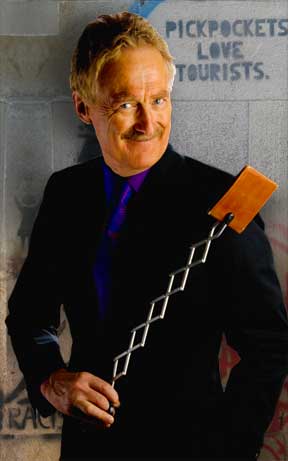
Huffington Post picked up an interview of Bob Arno from over on JustLuxe.com a few days ago. Here’s a reprint of the question and answers:
Among women who carry a purse or handbag, which ones are safest? How do you position the strap? What’s the worst mistake you see in how they hold and look after the bag?
Bob Arno: The worst, and the most common mistake, is to hang your handbag on back of the chair, or to tuck the bag behind you on the seat. You think you have physical contact with the bag, but fifteen minutes into the meal you forget! I’ve seen surveillance videos in which a gang of three thieves in a well-established luxury hotel restaurant position themselves strategically around a targeted breakfast table, talking to each other on their cell phones. They wait for the perfect moment when the owner of the bag — the victim — leans forward. At that moment, the controller of the gang gives a small hand signal to the other two to execute their independent moves so that everything is coordinated. One accomplice creates a small diversion in front of the table, and the other observes the restaurant staff, to be sure nobody pays attention to the incident. The thief unrolls a soft jacket from his fanny-pack and drapes it over his arm, allowing the fabric to come down over the victim’s handbag. He scoops up the bag under the cover of the nylon jacket. They then immediately leave the restaurant. Coffee shops (such as Starbucks and their competitors) are extremely popular venues for thieves who practice bag stealing.
Conclusion: You must have your purse in front of you and keep physical contact when traveling. If it is a purse with long strap, wear it in front of your body when you are in a vulnerable location or environment.
What’s the safest place for a man to carry his wallet?
BA: Men should carry their wallets in their tightest pocket. Still, that’s not always safe enough. For added security, men might try one of four kinds of under-clothes pouches which are comfortable and functional for easy access, but which make it almost impossible for thieves to steal from.
-
- 1. A pouch that hangs from a string around your neck and is worn under your shirt.
2. A pouch that hangs from your belt by a loop and is worn inside your pants.
3. Ankle-holsters in various designs and levels of sophistication.
4. Underclothing with built-in pockets for valuables. One new product is called Stashitware. Another line is made by Clever Travel Companion.
What’s the best way to respond to aggressive panhandlers, who may or may not be pickpockets?
BA: We’re programmed to be polite to strangers who approach us, even in unfamiliar cities. It’s hard to be cynical or always suspicious. But it’s wise to question the motivation behind an encounter, regardless of how friendly the stranger appears to be. Scammers want to lull you into a false sense of security and then spring the “rope-in” move. I like to prescribe a dose of cynicism, though it’s not to everyone’s taste. In any case, aggression should not be rewarded with a handout. Step aside. Disengage.
Further to that, do gypsies actually exist? Where are they a threat?
BA: In terms of stealing and pickpocketing, they do represent a threat. But they are not always attempting to pickpocket when they simply beg. Young female pickpockets in Europe, age 13-18, often originate from East Europe and belong indirectly to gangs, controlled by organized crime bosses. These bosses travel across East European cities and “lease” young girls from their parents with promises of lofty employment in the service sector in Western Europe. They are then “processed” or tutored in various techniques of pickpocketing. Finally, after the “schooling” they are sent to cities like Paris or London, where they’re chaperoned daily by their controllers at lucrative “theft” locations, such as busy public transportation stations, maybe underground Metros or popular music festivals. These criminals are not violent and are more a nuisance than a serious threat, yet one has to have one’s guard up against them. They’re especially prevalent in the big cities of Western Europe and the United Kingdom.
What should one watch out for in a crowded market or bazaar?
BA: It’s always hard for law enforcement to patrol and observe everything that goes on in a big market. And the thieves are good at spotting undercover police officers. The good thing is that the merchants in popular markets and bazaars have their own security who alert shop owners about lurking pickpockets.
There are many exotic and bustling markets, for example the Grand Bazaar in Istanbul, which appear threatening, but which are in fact extremely safe. Perception can be wrong in either direction. Without listing every exciting bazaar around the world and ranking its safety, lets just say that common sense should rule. Don’t carry more cash than you are prepared to lose. Use those under-clothes pouches. Keep your purse or backpack in front of you (or leave it in the hotel). Markets, generally speaking, accept cash but not always credit cards, although even that is changing now with the abundance of new small portable wireless terminals.
What’s the best way to look after cameras, iPhones and other devices popular with petty thieves?
BA: A smart phone can easily be grabbed off your outdoor café table, with the culprit running (faster than you). I have never met a pickpocket who isn’t using a cell phone he or she previously stole from someone. Have a wide sturdy strap on your camera which is not easy to yank loose. Be sure it has strong clips at the end of the strap. For extreme situations, buy a camera case that actually has an opening in the bottom where the lens points down towards the opening. In other words, wear your equipment in disguised bags which do not have brand name logos on them, but rather something that will throw the thief off his target scent.
Important: Never fight a mugger! Cameras can be replaced, but getting a sharp object shoved into your body is not a good exchange. You cannot predict the behavior of a mugger. Pickpockets on the other hand are not prone to violence.
Please discuss hazards of public transportation.
BA: Public transport is by far the most common locale for pickpocketing. Especially during the moment you enter the tram/car/bus — or depart (at the door). The busier the Metro or the bus is, the higher the risk. Real professional teams travel in groups of three and create their own choke-points or blocking scenarios. Understanding that a large percentage of pickpocket thefts happen on or at public transportation should be enough to cause you to plan carefully and be on guard if the train or tram is crowded. It’s the physical jostling which needs to be avoided. But it’s also extremely easy to avoid the threat with a few obvious counter-moves. Just clasp your handbag solidly in front of you when entering; men can hold onto their wallets.
What are the biggest risks in using an ATM in an unfamiliar location?
BA: There are two threats tied to ATMs. One is the “skimmer,” a small device overlaying the mouth of the ATM (where you push in the bank or credit card). Skimmers can usually be spotted if one looks carefully at the ATM. If you recognize such a device, walk away and alert proper security personnel. Some skimmers are internal, and can’t be seen at all.
Two, and more ingenious, are “shoulder surfers.” They lurk near the ATMs and watch the PIN code used at the machine. When they get a PIN code, they watch where the credit card is put, then follow that person around, waiting for a good moment to steal the credit card.
Always shield your PIN as you enter it. Watch for lurkers, and use a different ATM if you’re suspicious of bystanders or the machine itself. If your card is “eaten” by the machine, try to cancel out of the transaction, even if you have to abandon your card. Do not accept help from a stranger in this situation.
— — — —
Lena Katz wrote the questions.







No comment yet, add your voice below!